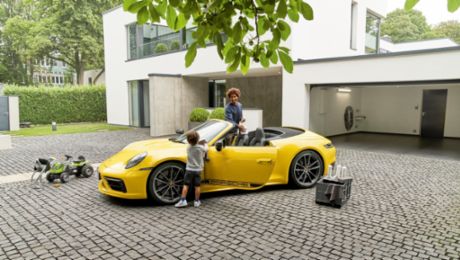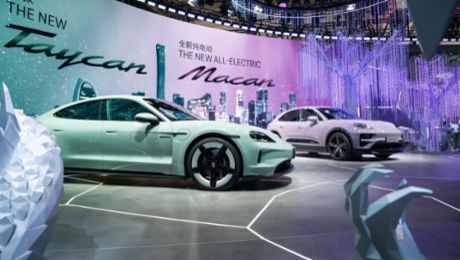Even higher performance.
All updated models accelerate much faster than their predecessors. Two examples from the lower and upper ends of the portfolio: As sports sedans, the Taycan Taycan (2024): Electric power consumption* combined (WLTP) 20.0 – 16.7 kWh/100 km, CO₂ emissions* combined (WLTP) 0 g/km, CO2 class A and Taycan Turbo S Taycan Turbo S (2024): Electric power consumption* combined (WLTP) 20.5 – 17.9 kWh/100 km, CO₂ emissions* combined (WLTP) 0 g/km, CO2 class A reach the 100 km/h mark from a standstill in just 4.8 and 2.4 seconds respectively. This makes them 0.6 and 0.4 seconds faster than their predecessors. With the new push-to-pass function[1] in the Sport Chrono package, a boost of up to 70 kW, depending on the model, can be called upon for 10 seconds at the touch of a button. The increased acceleration rates are generally the result of higher system output. For example, the base Taycan delivers 60 kW more than before. In the Taycan Turbo S, it’s an additional 140 kW with Launch Control.
Up to 35 per cent more range compared to the predecessor.
Depending on the body variant and engine, the WLTP range is increased to up to 678 km – an increase of 175 km or 35 per cent. The updated Taycan not only requires fewer charging stops on long trips than its predecessor, but it also recharges faster: at 800-volt DC charging stations, for example, it can be charged at up to 320 kW. That’s 50 kW more than before. With the greater charging stability, high charging capacities of more than 300 kW can even be sustained for up to five minutes. The fast-charging window of the new performance battery has been significantly expanded, which means that high charging capacities can be achieved more quickly even at low temperatures. Depending on the individual driving profile, this can cut the time required to go from a ten to an 80 per cent charge by half compared to the predecessor. In the first-generation Taycan, the charging time from ten to 80 per cent SoC (state of charge) at a battery temperature of 15 degrees Celsius is 37 minutes. Under the same conditions, the upgraded Taycan takes just 18 minutes despite its larger battery capacity.
New active chassis.
All updated Taycan models come with adaptive air suspension as standard. The new Porsche Active Ride suspension can be ordered as an option for the all-wheel drive versions. This system offers an unprecedented bandwidth between driving comfort and driving dynamics. The suspension keeps the body of the Taycan level at all times, even during dynamic braking, steering and acceleration manoeuvres. With a smooth ride, the system absorbs bumps almost completely. In dynamic driving situations, the Porsche Active Ride suspension ensures an all but perfect connection to the road thanks to a balanced distribution of wheel loads. If the appropriate mode is activated, the suspension can compensate for pitching and rolling motions in order to reduce the acceleration forces acting on the occupants.
Extensive efficiency measures.
The simultaneous improvement of performance and efficiency is down to a number of factors: an advanced powertrain with a new rear-axle motor with 80 kW more power than its predecessor on all models, a modified pulse inverter with optimised software, more powerful batteries, revised thermal management, a next-generation heat pump and a modified recuperation and all-wheel-drive strategy. The maximum recuperation capacity during deceleration from high speeds has increased by more than 30 per cent from 290 to up to 400 kW. All variants now come as standard with aerodynamically optimised wheels and reduced-rolling-resistance tyres. New 21-inch wheels and tyres were specially developed for this purpose.
Significantly improved equipment with less weight.
Although the standard equipment is even more extensive than before, the models are up 15 kg lighter[2]. Ambient lighting, ParkAssist with reversing camera, electrically folding exterior mirrors with mirror surround lighting, Porsche Intelligent Range Manager (PIRM), heat pump with a new cooling system, smartphone tray for wireless charging, electric charging ports on the driver and front passenger sides, Drive Mode switch and Power Steering Plus are all now standard features. The Taycan base models now also have adaptive air suspension and aluminium door sill protectors as standard. In addition to the upgraded equipment, the improved product specification includes a battery with increased capacity but with reduced weight.
Even more attractive design.
With new front- and rear-end styling with new headlights and tail lights, the experts at Style Porsche have further honed the clean, purist design of the Taycan. The new front wings and the flatter headlights give even greater emphasis to the width of the Taycan. The new headlights feature high-resolution HD matrix technology with detailed optics and now also display the brand’s characteristic four-point graphics at night. The Porsche logo in the rear light strip features a three-dimensional, glass-look design. It is available for the first time in an illuminated version with greeting animations when entering and exiting the vehicle. Among other notable features, the accent colour Turbonite makes the Turbo and Turbo S models stand out more distinctively from the other versions in both the exterior and interior.
Updated control and display concept.
The instrument cluster, central display and optional passenger display feature an optimised user interface with additional functions. The mode switch on the steering wheel now comes as standard. For Taycan models equipped with the Sport Chrono package and the Performance Battery Plus, there is a special push-to-pass button on the mode switch. Using the new control lever on the left behind the steering wheel, control of the driver assistance systems is even more intuitive. Apple CarPlay has been more deeply integrated into the vehicle displays and functions. The new In-Car Video function enables video streaming on the central display and the Passenger Display.
[1] Possible in combination with the Performance Battery Plus. Not available for 2WD models of the Taycan and Taycan Sport Turismo or the Taycan 4 Cross Turismo.
[2] Specifications for the Taycan Turbo compared to its predecessor.


